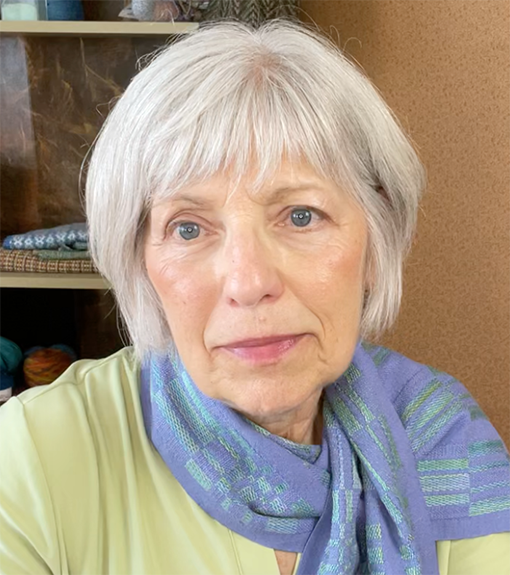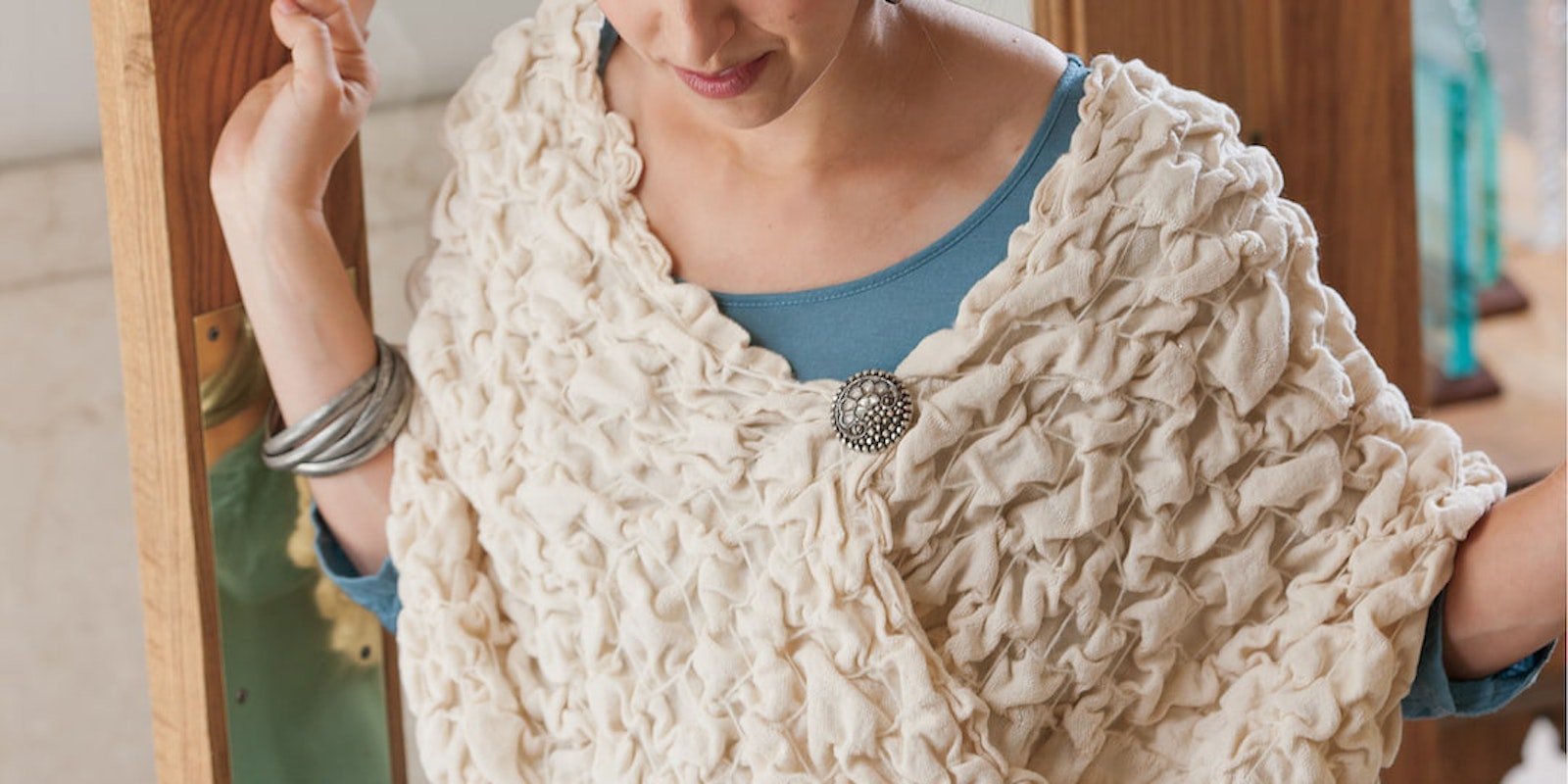Welcome to “Five Questions With,” where we get to know designers and their weaving a little better.
 For this edition we’re talking with Karen Donde, multi-shaft weaver and teacher, and the most recent past president of Complex Weavers. Karen teaches a broad range of popular weaving and design classes at conferences and for guilds, so we're thrilled that she’ll be joining us at our upcoming Weave Together with Handwoven retreat in beautiful York, Pennsylvania, March 23–27, 2025. One of her classes there will focus on the marvelous variety of structures based on plain weave (with lots of hands-on weaving time). In two others, she‘ll teach how to use photos or stash yarns for design inspiration.
For this edition we’re talking with Karen Donde, multi-shaft weaver and teacher, and the most recent past president of Complex Weavers. Karen teaches a broad range of popular weaving and design classes at conferences and for guilds, so we're thrilled that she’ll be joining us at our upcoming Weave Together with Handwoven retreat in beautiful York, Pennsylvania, March 23–27, 2025. One of her classes there will focus on the marvelous variety of structures based on plain weave (with lots of hands-on weaving time). In two others, she‘ll teach how to use photos or stash yarns for design inspiration.
Read on to learn more about the kind of weaver Karen is, as well as her joyful and inquisitive approach to design. She asks herself “What if . . . ?” and from there magic happens. —Lynn
L: One of your most memorable Handwoven projects is your wonderful Bubble Wrap. Can you tell me how that went from concept to finished piece?
Frankly, it was a fair bit of serendipity, or maybe timing. I was a student in the Haywood Community College Fiber Program at the time, and the weaving assignment was collapse weave. I came to Haywood with several years of weaving experience, which included a few frustrating months experimenting with differential shrinkage in deflected double weave. My work resulted in more misses than hits, until I finally finished one mostly successful project. (Ed. note: We‘d call this project fully successful, and published it as the Dozen Roses Scarf in the January/February 2010 issue of Handwoven.)
 Karen Donde‘s Dozen Roses Scarf design, from Handwoven‘s Jan./Feb. 2010 issue. Photo by Joe Coca
Karen Donde‘s Dozen Roses Scarf design, from Handwoven‘s Jan./Feb. 2010 issue. Photo by Joe Coca
After my lone success, I threw all my samples in a plastic bin, and shut it tight.
I didn’t think about collapse weave again until my assignment at Haywood. I reopened that bin and, having learned a few things in the meantime, decided to try again using a yarn I knew would shrink and full easily (Felting Pony from Henry’s Attic). I modified a deflected doubleweave pattern to enhance the differential shrinkage, added a few sparkly yarns to the white cotton warp, wove it, and carried it ever-so-carefully to the wash tub (it had very long, barely secured wool floats). I washed it and, voilà, bubbles! Really big ones!
For the assignment I had to figure out what the finished piece would become. I draped it over one of the classroom mannequins with a twist in it and walked away. The instructor, Amy Putansu, walked by and said, “Oh, I like that.” I sewed the ends together with the twist, creating a mobius strip, and named it Bubble Wrap.
L: What kinds of inspiration do you draw from when designing a draft? When a project is woven, do you look back at the inspiration and consider whether you hit the mark? Or does working through the process change the goal?
I’m always on the lookout for interesting patterns, and I’m not just talking about weave structures—I mean the designs that appear in the woven cloth regardless of how the threads interlace to create them. However, that’s just the start of the idea, because finding a weave structure to replicate a pattern like zebra stripes, tree bark, or cloud formations can be tough unless you have a Jacquard loom.
So I’m using what I know about structures and weaving techniques to capture the general look and feel of the pattern that grabbed my interest. And those decisions can change during the course of designing, sampling, and even weaving a piece. If you compared the finished piece to the pattern that inspired it, you might see no connection. But the inspiration led me down that design road, which probably had several twists and turns along the way.
Working through the process and evaluating final results almost always points me to a new goal.
 Karen wove Red Mobius in turned beiderwand using hand-dyed Tencel, rayon, and bamboo. Photo courtesy Karen Donde
Karen wove Red Mobius in turned beiderwand using hand-dyed Tencel, rayon, and bamboo. Photo courtesy Karen Donde
L: Do you have a desert-island structure—something you could happily weave (and be inspired by) for the rest of your life?
Absolutely. It's what I refer to as turned beiderwand, because that's how I discovered it.
Beiderwand is a tied weave with clean pattern blocks reminiscent of block doubleweave, but on fewer shafts. Because tie-down shafts are shared by all beiderwand blocks, the structure produces two-layer pattern blocks surrounded by tied single cloth vs. doubleweave’s two layers throughout. Turning a beiderwand draft retains the clean block edges, but with better drape, and faster one-shuttle weaving than its traditional supplementary weft method.
The resulting threading—a double two-tie—also adapts easily to weave many other structures, including an idea for plaited twill I’m now exploring more deeply.
L: What’s a personal project you’ve woven recently?
Teaching weaving, developing classes, and weaving samples for those classes has kept me very busy since the pandemic. I also spent two of those years serving as president of Complex Weavers. So time for personal projects has been limited of late.
A few years ago, probably during the pandemic, I saw a story on CBS Sunday Morning about painter Pierre Soulages, who was known for creating all-black paintings with textural patterns that only show up under the right lighting. I wondered whether I could do that in weaving.
I ordered as many different varieties of black yarn as I could find and started sampling. I ended up with three panels, all black, each with a different woven textural pattern created through a combination of weave structure and yarn.
Unfortunately, the project stalled when I tried to figure out the best way to display the panels so they would hang straight but move freely. My first effort didn’t achieve the results I wanted, so I got frustrated, rolled it all up, and put it in the closet. Sound familiar?
One day I’ll have a reason to pull it out and figure out the best way to mount it. Maybe I’ll have learned a few more things by then.
L: What’s on your loom right now?
Unfortunately, only the remains of all the samples I wove in preparation for the teaching I was doing last spring and summer. After Convergence, my husband and I spent most of August cruising the Mediterranean, exploring, and taking pictures. There was so much inspiration, I’m still processing it all.
I taught a workshop on plaited twills at Convergence, and will be teaching that subject again next summer, so for the near future, there will be more plaited twill sampling, and maybe a scarf or two.
However, I brought another idea home with me from Complex Weavers Seminars that takes plaited twill to a completely different level. I can’t wait to experiment with that. Thank you, Brenda Gibson! It would be great if those two sources of inspiration—Mediterranean travel and plaited twill—came together in some way.
———
It was such a delight to talk with Karen about her approach to weaving and design. If you enjoyed it as much as I did, you can read Karen‘s answers to more questions over at our Little Looms sister website. And if you want to learn from Karen in person, don‘t delay—a few tickets are still available for our 2025 Weave Together with Handwoven retreat, but they‘re going fast!
Happy weaving!
Lynn

